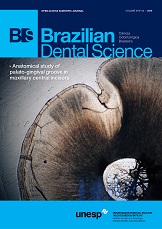Evaluation of the life quality in patients with Temporomandibular Disorders
DOI:
https://doi.org/10.14295/bds.2015.v18i3.1144Abstract
AIMS: To evaluate influence of variables gender, diagnosis and severity of types of Temporomandibular Disorder (TMD) on the quality of life of the individual. METHODS: The sample consisted of one hundred one individuals seeking TMD treatment at the Faculdade de Odontologia/ Universidade Federal de Juiz de Fora. The TMD diagnosis was done through the RDC/TMD: Axis I (Research Diagnostic Criteria/Temporomandibular Disorder). The severity of TMD was established by the Temporomandibular Index (TMI) and the impact on quality of life by the OHIP-14 (Oral Health Impact Profile). The data was tabulated and analyzed by the Mann-Whitney test, T student test and Spearman correlation analysis (?=0,05). RESULTS: Most patients had diagnosis of muscular disorder, followed by diagnoses of arthralgia and disk displacement, respectively. All patients had a negative impact on at least one question from OHIP-14.CONCLUSIONS: Women presented worse quality of life when compared to men. The presence of muscular disorder was related to greater impact on quality of life (p<0,05). The relationship between severity of TMD and quality of life in the muscle sub-index of TMI was observed in all domains of OHIP-14 (p<0,05). In addition, there was positive correlation between TMI and the psychological incapacity.
Downloads
Downloads
Additional Files
Published
How to Cite
Issue
Section
License
Brazilian Dental Science uses the Creative Commons (CC-BY 4.0) license, thus preserving the integrity of articles in an open access environment. The journal allows the author to retain publishing rights without restrictions.
=================




























